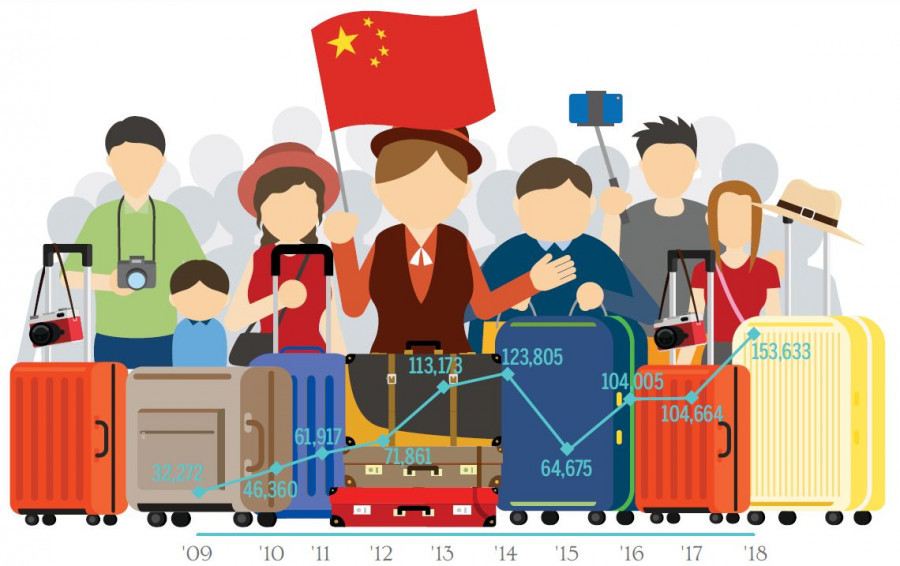Money
China’s ban on outbound tours certain to affect the Visit Nepal campaign
Visit Nepal plans to attract 350,000 Chinese tourists, which is looking increasingly unlikely in the face of the coronavirus outbreak.
Sangam Prasain
Scrambling to contain the spread of the coronavirus epidemic, China has instructed all travel companies to temporarily stop selling international tour packages, presenting a significant challenge to Visit Nepal 2020.
The travel ban, if prolonged, could largely dampen Nepal’s ambitious Visit Nepal campaign this year, as the country plans to attract 350,000 Chinese travellers, the country’s second largest source market.
The ban could also significantly impact the country’s economy as restaurants, hotels, and transportation and trade sectors could be hit significantly in February and March and slacken through the rest of the year even if the virus is controlled, industry insiders said.
On Sunday, China’s Ministry of Culture and Tourism issued an emergency notice ordering national travel agencies and online travel companies to temporarily suspend tour packages.
“From now on, national travel agencies and online travel companies will temporarily suspend business group travel and ‘ticket + hotel’ travel products,” said the notice.
However, groups that are already out of the country will be allowed to complete their itinerary.
As of Sunday, according to some Chinese airline representatives the Post spoke to, the travel ban has not affected airlines so far but could gradually impact them. Nepali travel trade entrepreneurs said that all tour packages sold for February have been cancelled.
“Some Chinese airlines in Nepal have issued a notice that they will fully refund passengers if they wish to cancel their tips,” said Shyam Raj Thapaliya, managing director at the Osho World Travel Nepal travel agency. “Cancellations, however, have not begun yet. But no travel means no flights.”
Even transit passengers are inquiring about their flight status, he said.
The travel restriction may impact around 120 weekly flights movements to and from Kathmandu and may cause a loss of billions of rupees to the travel and trade industry.
“We were expecting February and March to be bumper months because we [tour operators] had arranged dozens of charter flights to bring in tourists from China as scheduled flights were already sold out,” said Bishwesh Shrestha, managing director of Shuang Qi Tours and C&K Nepal Treks, one of the major travel agencies handling Chinese tourists.
“Based on the current booking trend, we were expecting possibly 300,000 Chinese tourists this year,” he said. “We cannot say right now what the impact of the virus outbreak will be on our business.”
As the Chinese government has issued a notice to airlines and tour operators not to charge cancellation fees, the travel trade in Nepal and China is set to lose a lot of money, said Shrestha.
“Airlines will be hit the most,” he said.
The move comes at the start of the Lunar New Year holidays when millions of Chinese travel across the country and abroad.
Kishore Raj Pandey, chairman of Saathi Nepal Travel and Tours, the first tour operator to bring Chinese tourists to Nepal, said arrivals from China could plunge to zero in February, a key month for travel.
There were more than 16,000 Chinese holidaymakers in February last year.
“Bookings for nearly 700 Chinese tourists in February from my company alone have been cancelled,” said Pandey. Bookings from China had been ‘encouraging’ from the start of this year following Chinese President Xi Jinping’s visit to Nepal last October.
Tourism entrepreneurs said that strengthening Nepal-China ties had become a
'silver lining' for the Nepali tourism industry.
“The peak season is gone. It’s difficult for the growth momentum to continue,” Pandey told the Post. “If the travel ban is extended for a longer period—possibly up to March—the impact on travel businesses will be catastrophic.”
Arrivals from China rose 10.35 percent to 169,543 individuals last year. Among them, 151,200 came by air.
Last Thursday, private carrier Himalaya Airlines added Chongqing, a city in southwestern China, to its network, following Beijing, Changsha, Guiyang and Shenzhen. The same day, Chongqing confirmed five cases of infection from the virus.
Vijay Shrestha, vice-president of administration at Himalaya Airlines, said they have been discussing whether they should also temporarily suspend Kathmandu-Beijing flights.
“We have already suspended or postponed flights on other sectors like Chongqing, Changsha, Guiyang and Shenzhen,” Shrestha told the Post. “As the Chinese government has been taking the virus threat seriously, we don’t think the travel ban will continue for long.”
But according to tourism entrepreneurs, Nepal does not have alternatives to Chinese tourism’s contributions to Visit Nepal.
“It’s Visit Nepal year and if one source market suffers, the momentum should not stop,” said Ashok Pokhrel, a tourism entrepreneur. “But I don’t think the government has a Plan B.”
China on Sunday morning announced 15 more deaths from the new coronavirus, including one in Shanghai, the first reported so far in the metropolis. Across the country, 688 new cases of the virus were diagnosed on Saturday, bringing the total number of confirmed cases to 1,975.
Since the beginning of the year and the national tourism campaign, Nepal’s tourism industry has already seen a number of high-profile mishaps. Earlier this month, a family of Indian tourists died from suffocation inside a poorly ventilated resort room and a number of South Korean trekkers went missing in the Annapurna area. Politicisation has also prevented the appointment of a new chief at the country’s tourism promotion body, which industry insiders say clearly shows that no one in the country is taking the responsibility to promote tourism.
“The dependency on a single market is not a good strategy, and Nepal seems to have its priorities misplaced,” said tourism entrepreneur Shrestha. “Nepal needs to be able to tell the world that it’s safe here. Otherwise, Visit Nepal is finished.”




 10.12°C Kathmandu
10.12°C Kathmandu













%20(1).jpg&w=300&height=200)
